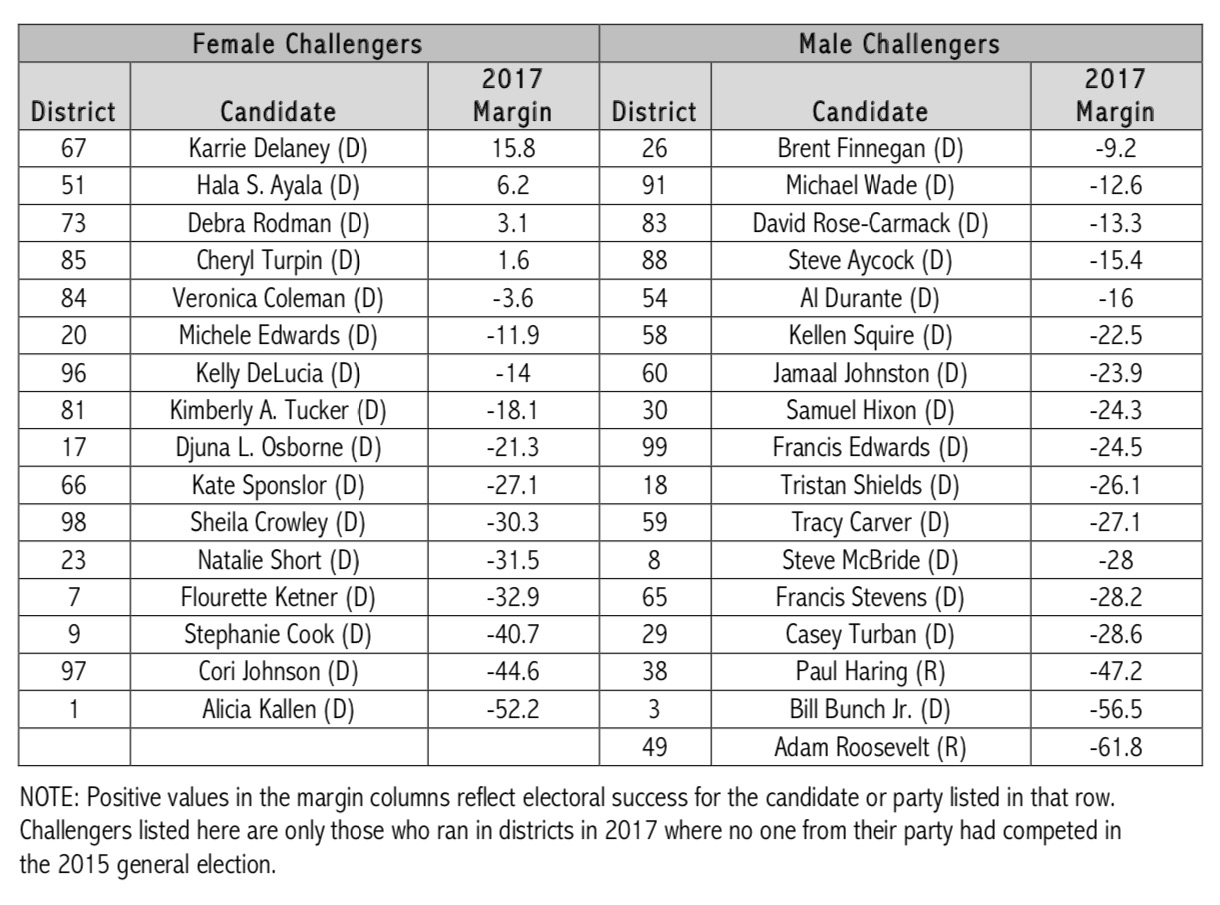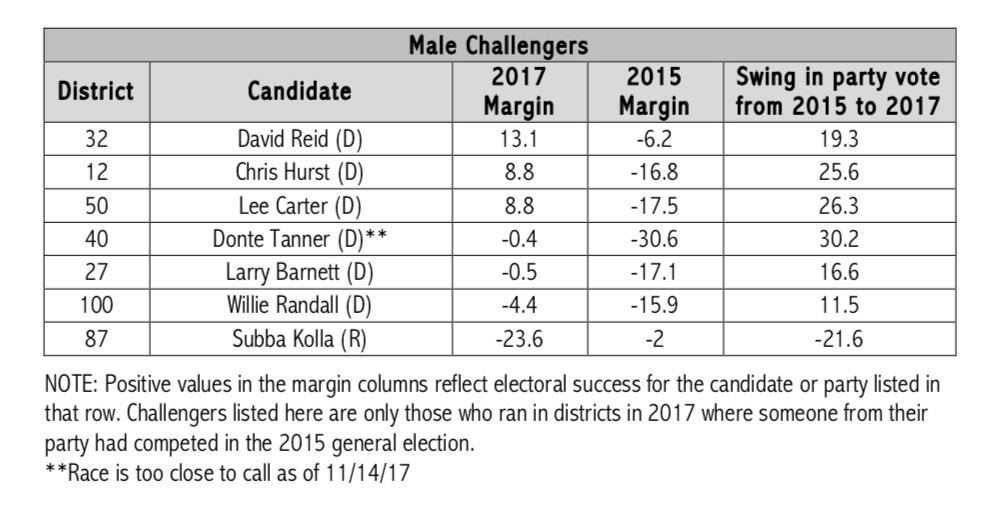Thirty women challengers ran for Virginia’s House of Delegates on Tuesday; all but three were Democrats. Of those thirty, nine (30%) – all Democrats – won, and one Democratic woman’s race is too close to call. This success rate for challengers is rare. In fact, while 24 men ran as challengers in 2017, just 3 (12.5%) were successful. One male challenger’s contest is still too close to call. Put differently, women were 56% of all challengers, but 75% of the successful challengers in Virginia’s House of Delegate races this year.
To better understand the context for – and unlikelihood of -- these victories, we drilled down further to compare results in each House of Delegates district where a woman ran in 2017 with results in the 2015 election. Here are a few key findings (with numbers attached!):
- Sometimes high risk does reap high rewards. Some women who ran as challengers in races previously uncontested by Democrats surprised many with their success.
- Wide swings in Democratic support from 2015 to 2017 were key to victories for men and women challengers. These dynamics upended conventional wisdom that challengers’ success would be highly unlikely.
- Republican challengers were few in number and confronted strong headwinds. Just one new Republican woman was elected in Virginia’s House of Delegates, and she won an open seat.
1. Sometimes high risk does reap high rewards.
In 2017, Democratic candidates challenged Republicans in 31 Virginia House districts where those Republicans ran unopposed in 2015. They took on high risks, as the precedent in each of these districts indicated slim chances of success. The results were largely as expected, but four of these challengers won. Importantly, they were all women. Their margins of victory ranged from two to 16 points.
Vote Margins for Virginia House of Delegates Challengers in Previously Uncontested Districts, November 2017

2. Wide swings in Democratic support from 2015 to 2017 were key to victories for men and women challengers.
Democratic challengers competed in 17 districts where their Republican opponents had also been challenged in 2015, and they won in about half of them. Women were nearly two-thirds (11 of 17) of those challengers, and are the same proportion of the winners of these contests; five women and three men won, and both a man and a woman are candidates in races where the results are too close to call. The average margin of victory for the five successful Democratic woman challengers was 5.5 points (ranging from 0.9 to 9.8 points), and these women, on average, swung their districts’ voter support 21.8 points from 2015 to 2017 (ranging from 16.7 to 28.1 points). The three successful male challengers, on average, swung their districts 23.7 points from 2015 to 2017 (ranging from 19.3 to 26.3 points).
Even where they were unsuccessful, Democratic challengers narrowed margins of defeat from 2015 to 2017. On average, the five defeated women challengers in these contests cut the Republican advantage in their districts by 11.9 points (ranging from 0.8 to 16.4 points), and the two defeated men cut the Republican advantage in their districts by an average of 14.1 points.
Vote Margins & Swing in District Party Vote from 2015 to 2017 for Virginia House of Delegates Challengers, November 2017


3. Republican challengers were few in number and confronted strong headwinds.
Just six Republican challengers, three women and three men, competed in Virginia’s elections, representing 11% of all House challengers in 2017. All of them lost, and by much larger margins than had Republicans competing in the same districts in 2015.
The average margin of defeat for the three Republican women challengers in 2017 was 26.4 points (ranging from 20.1 to 37.2 points). In 2015, the average margin of defeat for Republican women nominees in those districts was 8.2 points (ranging from 2.6 to 12.5 points). In each of these districts, Republican women lost ground - anywhere from 10.5 to 24.7 points in support - between 2015 and 2017.
The average margin of defeat for the three Republican men challengers in 2017 was 4.2 points (ranging from 23.6 to 61.8 points). In only one of these districts was there a Republican candidate in 2015; in that race (District 87), the Republican nominee was defeated by 2 points in 2015, but 23.6 points in 2017.
How do these findings compare to women’s candidacies for open seats and as incumbents?
Three of the six women candidates running for open seats in Virginia’s House of Delegates won on Tuesday, including two Democrats and one Republican. Importantly, two of the four open seat contests in which women competed were woman vs. woman races.
- The most striking swing between 2015 and 2017 occurred in District 42, where Democrat Kathy Tran won a seat by 22 points that had been won by the Republican incumbent by 27 points in 2015, yielding a nearly 50 point swing.
- In District 2, Democrat Jennifer Carrol Foy defeated her Republican opponent by 26 points. In 2015, the Democratic nominee in that district was defeated by 1 point.
- Emily Brewer was the only new Republican woman elected to the House of Delegates in 2017. She defeated her Democratic opponent by 25 points in a district where the Republican incumbent had run unopposed in 2015.
Finally, all of the 15 incumbent women candidates in Virginia, including 11 Democrats and 4 Republicans, were re-elected. Nine (8D, 1R) were unopposed. Consistent with the trends across races, Democratic women incumbents increased their margins of success from 2015 (except for in cases where they were opposed in 2017 and not in 2015), and Republican women’s margins of success narrowed in 2017, in one case to just 0.5 points.


